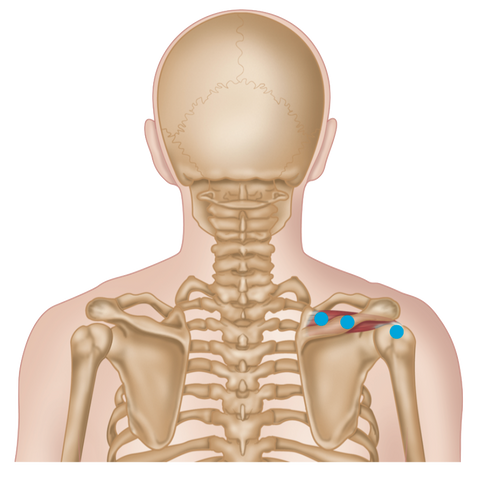Rotator Cuff Trigger Points - Supraspinatus
Treating Supraspinatus Trigger Points - Dr. Jonathan Kuttner
Ischemic Compression Technique
About Supraspinatus
Latin supra, above; spina, spine
A member of the rotator cuff, which comprises the supraspinatus, infraspinatus, teres minor, and subscapularis. The rotator cuff helps hold the head of the humerus in contact with the glenoid cavity (fossa, socket) of the scapula during movements of the shoulder, thus helping to prevent dislocation of the joint.

Supraspinatus - Common Trigger Point Sites
Origin
Supraspinous fossa of scapula.
Insertion
Upper aspect of greater tubercle of humerus. Capsule of shoulder joint.
Action
Initiates process of abduction
at shoulder joint, so that deltoid can take over at later stages of abduction.
Antagonists: infraspinatus, teres minor, pectoralis major, latissimus dorsi.
Nerve
Suprascapular nerve, C4, 5, 6, from upper trunk of brachial plexus.
Basic Functional Movement
Example: holding a shopping bag away from side of body.
Referred Pain Patterns
Belly: deep ache in regimental badge area (4–6 cm). Ellipse
leads to zone of pain in lateral epicondyle/radial head. Diffuse pain into lateral forearm.
Insertion: localized zone of pain 5–8 cm over deltoid.
Indications
Loss of power in abduction, painful arc syndrome, night pain/ ache, subacromial bursitis, rotator cuff tendinopathy, deep achingin shoulder which can extend to elbow (i.e. tennis elbow) and occasionally to thumb side of wrist, can be confused with De Quervain’s tenosynovitis, pain on initiation of lifting shoulder sideways, inability to reach behind back, moderately restricted range of shoulder motion, clicking/snapping sounds in shoulder joint.
Causes
Carrying heavy objects (e.g. bags, laptops, suitcases) over long distances, heavy lifting from floor to trunk of car, carrying with arms above head, sleeping positions with arms above head, dogs pulling on leash, falls on outstretched arm (e.g. skiing), washing/combing hair, moving heavy furniture, repetitive strain injury (RSI), prolonged computer keyboard use.
Differential Diagnosis
Phase 1 capsulitis. C5–C6 radiculopathy. Subacromial bursitis (adhesive). Calcific tendonitis. Calcium boils. Rotator cuff tendinopathy.
Find a Trigger Point Professional in your area
Dry Needling for Trigger Points
Certify as a Trigger Point Therapist
Recommended Starter Packs:
This trigger point therapy blog is intended to be used for information purposes only and is not intended to be used for medical diagnosis or treatment or to substitute for a medical diagnosis and/or treatment rendered or prescribed by a physician or competent healthcare professional. This information is designed as educational material, but should not be taken as a recommendation for treatment of any particular person or patient. Always consult your physician if you think you need treatment or if you feel unwell.

Ready to take your practice to the next level?
Explore which continuing education course is right for you.















